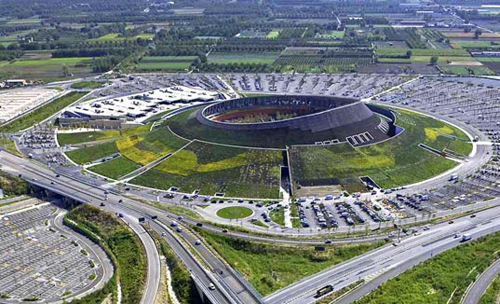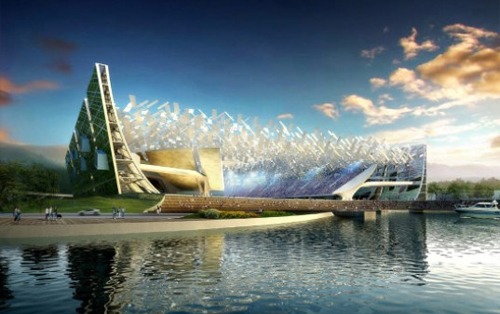A Proposal for Naturetecture
Mon, Sep 21, 2009 Albert Lam Albert Lam, Sustainable Design, Green Roofs, Architecture, Bioswales, Naturetecture
 Take a birds-eye view of any city, and one is liable to find a lot of gray and brown splotches. Gravel rooftops, concrete sidewalks, asphalt roads ... all of these are predominant aspects of many urban areas, and the shear expanse can be staggering when viewed from a more widespread frame. But imagine if this drab rug of impermeable spaces was replaced with a verdant tapestry of green foliage that spread out over rooftops, filtered through streets, even climbed up building envelopes. That was the mental image that popped into my head when I recently read about two intriguing projects--one completed the other still in a conceptual stage--located on opposite ends of the globe.
Take a birds-eye view of any city, and one is liable to find a lot of gray and brown splotches. Gravel rooftops, concrete sidewalks, asphalt roads ... all of these are predominant aspects of many urban areas, and the shear expanse can be staggering when viewed from a more widespread frame. But imagine if this drab rug of impermeable spaces was replaced with a verdant tapestry of green foliage that spread out over rooftops, filtered through streets, even climbed up building envelopes. That was the mental image that popped into my head when I recently read about two intriguing projects--one completed the other still in a conceptual stage--located on opposite ends of the globe.
The Vulcano Buono, in Nola, Italy, is a massive commercial shopping complex that rises out of the ground like an elegant dome volcano that just happens to be covered in a rich blanket of greenery. More than 2,500 plants provide a sustainable carpet that covers an array of shops and restaurants, a cinema complex, an outdoor amphitheater, a hotel, and a market, creating a design that is every bit as much landscape as it is architecture.
In China, the design for the new Dalian Shide Stadium plays upon the idea of the earth itself opening up to envelope an open sports arena. Two massive walls cradle seating and field areas, and each wall is covered with plants and grass which transform the barriers into monumental green lattices that bend the traditional garden vertically. Topping the structure is a network of cables and fabric structures that reiterate the motif of airy openness.  Both jaw-dropping projects are excellent examples of architecture that blurs the boundaries between the natural world and the artificial, bringing nature back into the built environment. This blending of two traditionally disparate disciplines is a wonderful example of holistic design, and the type of work that inspires me to envision wonderful possibilities in the world of sustainable design. I take the captivating image of the Vulcano Buono and think how that might look spread out over a low-rise neighborhood, where tree-lined pedestrian-friendly garden walks might give way to green terraces and roof gardens. I transplant those iconic walls of Dalian Shide Stadium into a city center and think how amazing it might be to have an urban park change dimension and traverse up and over an office tower.
Both jaw-dropping projects are excellent examples of architecture that blurs the boundaries between the natural world and the artificial, bringing nature back into the built environment. This blending of two traditionally disparate disciplines is a wonderful example of holistic design, and the type of work that inspires me to envision wonderful possibilities in the world of sustainable design. I take the captivating image of the Vulcano Buono and think how that might look spread out over a low-rise neighborhood, where tree-lined pedestrian-friendly garden walks might give way to green terraces and roof gardens. I transplant those iconic walls of Dalian Shide Stadium into a city center and think how amazing it might be to have an urban park change dimension and traverse up and over an office tower.
If that sounds too science fiction, it's only because our current environment is so desperately devoid of such features. But if new developments of all varieties were to steadily incorporate these strategies into everyday design, such a reality could come sooner than one might expect. Take green roofs, which Andrew Wickham has already so expertly covered. Atop urban building pads, they bring a reinvigorating sense of nature to an often lifeless constructed ambiance. As part of a school or educational facility, they can help students directly understand the importance of environmental issues. Mixed into homes, they improve insulation and could even be used for gardening and mini-farming, thereby increasing self-sufficiency. Other tactics, such as pervious paving in lower trafficked zones, bioswales, or even the simple act of adding foliage and natural shade to otherwise barren streets or plazas, can also contribute.
Ultimately, the goal remains bringing elements currently associated with specialized sustainable design into the realm of normalcy. Because I personally think it would be really cool to one day walk through a city, see landscape beautifully intertwined with architecture, and realize it's now a best practice and no longer the measure of a sustainable project.
Albert Lam is a Project Coordinator at California-based LPA Inc. He is a LEED accredited professional who specializes in the design and implementation of K-12 schools.